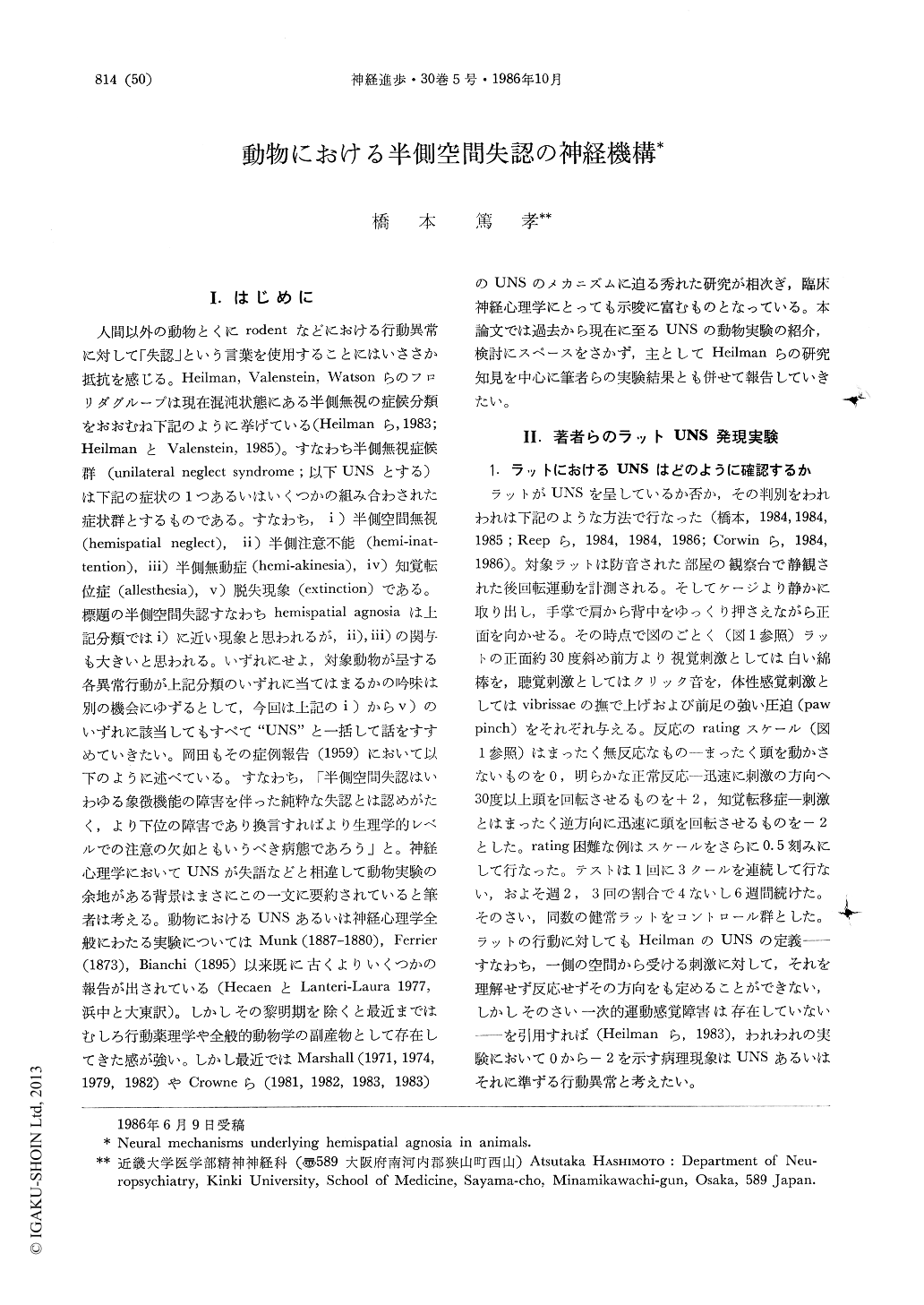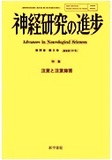Japanese
English
- 有料閲覧
- Abstract 文献概要
- 1ページ目 Look Inside
I.はじめに
人間以外の動物とくにrodentなどにおける行動異常に対して「失認」という言葉を使用することにはいささか抵抗を感じる。Heilman,Valenstein,Watsonらのフロリダグループは現在混沌状態にある半側無視の症候分類をおおむね下記のように挙げている(Heilmanら,1983;HeilmanとValenstein,1985)。すなわち半側無視症候群(unilateral neglect syndrome;以下UNSとする)は下記の症状の1つあるいはいくつかの組み合わされた症状群とするものである。すなわち,i)半側空間無視(hemispatial neglect),ii)半側注意不能(hemi-inattention),iii)半側無動症(hemi-akinesia),iv)知覚転位症(allesthesia),v)脱失現象(extinction)である。標題の半側空間失認すなわちhemispatial agnosiaは上記分類ではi)に近い現象と思われるが,ii),iii)の関与も大きいと思われる。いずれにせよ,対象動物が呈する各異常行動が上記分類のいずれに当てはまるかの吟味は別の機会にゆずるとして,今回は上記のi)からv)のいずれに該当してもすべて"UNS"と一括して話をすすめていきたい。岡田もその症例報告(1959)において以下のように述べている。すなわち,「半側空間失認はいわゆる象徴機能の障害を伴った純粋な失認とは認めがたく,より下位の障害であり換言すればより生理学的レベルでの注意の欠如ともいうべき病態であろう」と。神経心理学においてUNSが失語などと相違して動物実験の余地がある背景はまさにこの一文に要約されていると筆者は考える。動物におけるUNSあるいは神経心理学全般にわたる実験についてはMunk(1887-1880),Ferrier(1873),Bianchi(1895)以来既に古くよりいくつかの報告が出されている(HecaenとLanteri-Laura 1977,浜中と大東訳)。しかしその黎明期を除くと最近まではむしろ行動薬理学や全般的動物学の副産物として存在してきた感が強い。しかし最近ではMarshall(1971,1974,1979,1982)やCrowneら(1981,1982,1983,1983)のUNSのメカニズムに迫る秀れた研究が相次ぎ,臨床神経心理学にとっても示唆に富むものとなっている。本論文では過去から現在に至るUNSの動物実験の紹介,検討にスペースをさかず,主としてHeilmanらの研究知見を中心に筆者らの実験結果とも併せて報告していきたい。
As Crowne reported, unilateral selective break-down of rat anteromedial prefrontal cortex (shoulder area) results in unilateral neglect syndrome (Heilman, et al.), at least unilateral neglect-like behavior. Corwin, Hashimoto and Watson recognized the same pathological phenomenon in rats after producing the same lesion, as Crowne found. Evaluating test for unilateral neglect syndrome which we had made for this behavior is composed of visual, auditory and somatosensory unilateral stimulation respectively. Results indicated that unilateral artificial anteromedial prefrontal cortex lesion induces polymodal neglect. The most important region in rat anteromedial prefrontal cortex in terms of unilateral neglect syndrome, we speculated, might have been medial precentral cortex (PCm). Horseradish peroxidase examination revealed the afferent connections of PCm and autoradiographic investigation proved the efferent one. Afferent connections to PCm are as follows; ventral lateral, mediodorsal, central lateral and ventromedial thalamic nuclei ; contralateral PCm; ipsilateral cortical areas related to visions, somatic sensation and audition ; retrosplenial and ventrolateral orbital cortex. Efferent connections from PCm are as follows ; ventrolateral orbital cortex, visual, auditory and somatic sensory regions, and limbic/paralimbic areas including insular, perirhinal, retrosplenial, and presubicular fields ; ventral lateral, central lateral, paracentral, mediodorsal and ventromedial nuclei of thalamus; reticular, anteromedial, central medial, gelatinosus, parafascicular and posterior nuclei; central gray, superior colliculus and pontine gray. Both afferent and efferent connections of PCm are fundamentally reciprocal. Anatomically PCm bears certain striking resemblance to the eye field, supplementary motor and arcuate premotor areas of monkey cortex. Using apomorphine, a dopamine agonist and spiroperidol, a dopamine receptor blocking agent, either separately or mixedly, we did neuropsychopharmachological study in rats which anteromedial prefrontal cortex had been destroyed unilaterally. Apomorphine significantly improved a rat unilateral neglect syndrome, but this effect was blocked dramatically by prior administration of spiroperidol. These results indicated important role of dopamine systems in rat neglect by a unilateral lesion of prefrontal cortex. According to Florida group's (Heilman, Valenstein, Watson and their colleagues) hypothesis of underlying mechanisms of unilateral neglect syndrome which are functionally attention-arousal-activation hypothesis and anatomically corticolimbic-MRF loop hypothesis, we reviewed the responsible portion for unilateral neglect syndrome in the animal brain. At present, these are thought to be prefrontal cortex (especially arcuate sulcus), inferior parietal lobule, both banks of superior temporal sulcus, mesencephalic reticular formation, centromedian parafascicularis thalami, basal ganglia, limbic system (especially cingulate gyrus). As though it was negative data, we examined unilateral electrocoagulation of septal nucleus. Results of Marshall, Corwin and Reep support that rat unilateral neglect syndrome after unilateral damage of anteromedial prefrontal cortex were associating strongly with both cortical and subcortical involvement also biochemically with brain dopamine pathway. We suppose that the underlying mechanisms of unilateral neglect syndrome will be stressed by the anticipation of motor system more clearly than we had thought before. Studies in this field will make rapid progress with the assistance of 2-DG or electrophysiological procedure in near future.

Copyright © 1986, Igaku-Shoin Ltd. All rights reserved.


